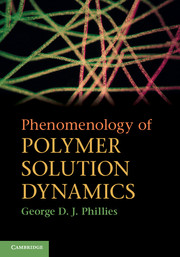Book contents
- Frontmatter
- Contents
- Preface
- 1 Introduction
- 2 Sedimentation
- 3 Electrophoresis
- 4 Quasielastic light scattering and diffusion
- 5 Solvent and small-molecule motion
- 6 Segmental diffusion
- 7 Dielectric relaxation and chain dimensions
- 8 Self- and tracer diffusion
- 9 Probe diffusion
- 10 Dynamics of colloids
- 11 The dynamic structure factor
- 12 Viscosity
- 13 Viscoelasticity
- 14 Nonlinear viscoelastic phenomena
- 15 Qualitative summary
- 16 Phenomenology
- 17 Afterword: hydrodynamic scaling model for polymer dynamics
- Index
- References
10 - Dynamics of colloids
Published online by Cambridge University Press: 05 August 2012
- Frontmatter
- Contents
- Preface
- 1 Introduction
- 2 Sedimentation
- 3 Electrophoresis
- 4 Quasielastic light scattering and diffusion
- 5 Solvent and small-molecule motion
- 6 Segmental diffusion
- 7 Dielectric relaxation and chain dimensions
- 8 Self- and tracer diffusion
- 9 Probe diffusion
- 10 Dynamics of colloids
- 11 The dynamic structure factor
- 12 Viscosity
- 13 Viscoelasticity
- 14 Nonlinear viscoelastic phenomena
- 15 Qualitative summary
- 16 Phenomenology
- 17 Afterword: hydrodynamic scaling model for polymer dynamics
- Index
- References
Summary
Introduction
We move in this chapter from random coils to colloidal particles. This chapter treats transport properties of colloid solutions that are directly analogous to the polymer properties considered in the remainder of this volume, including single-particle diffusion, mutual diffusion and quasielastic light scattering, rotational diffusion, viscosity, and viscoelastic properties. Colloidal particles have a wide range of shapes; this chapter emphasizes spheres. Some systems treated here are thermo-dynamically stable; in others, the density difference between colloid and solvent is large enough such that the particles tend to settle. This distinction is purely a consequence of the strength of the local gravitational field, and has no fundamental significance.
Why is it of interest to consider colloid dynamics?
First, the fundamental forces between neutral colloidal spheres are the same as the fundamental forces between neutral polymers. Polymers and colloids are equally subject to excluded-volume forces, hydrodynamic forces, van der Waals interactions, and to the random thermal forces that drive Brownian motion.
Second, the dynamic equations for polymer motion and for colloid motion are qualitatively the same, namely they are generalized Langevin (e.g.,Mori–Zwanzig) equations, including direct and hydrodynamic forces on each colloid particle or polymer segment, hydrodynamic drag forces, and “random” thermal forces due to solvent motion, all leading to coupled diffusive motion.
Because the forces and the dynamic equations of motion are fundamentally the same, it should not be surprising that the dynamic behaviors of polymers and colloids have substantial similarities.
- Type
- Chapter
- Information
- Phenomenology of Polymer Solution Dynamics , pp. 287 - 319Publisher: Cambridge University PressPrint publication year: 2011



